
The meadow brown is a butterfly found in the Palearctic realm. Its range includes Europe south of 62°N, Russia eastwards to the Urals, Asia Minor, Iraq, Iran, North Africa and the Canary Islands. The larvae feed on grasses.

The silver-washed fritillary is a common and variable butterfly found over much of the Palearctic realm – Algeria, Europe and across the Palearctic to Japan.

The Adonis blue is a butterfly in the family Lycaenidae. It inhabits the Palearctic realm.

Melanargia galathea, the marbled white, is a medium-sized butterfly in the family Nymphalidae. Despite its common name and appearance, this butterfly is one of the "browns", of the subfamily Satyrinae.
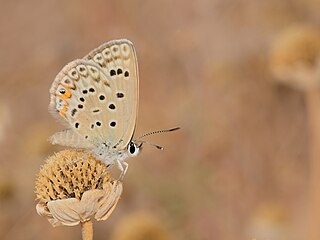
Plebejidea loewii, the large jewel blue, is a species of blue (Lycaenidae) butterfly.
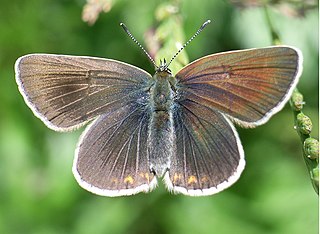
Eumedonia eumedon, the geranium argus, is a butterfly of the family Lycaenidae. It is found in the Palearctic realm. This butterfly has been included in the genera Plebejus, Plebeius, Polyommatus and Aricia, but recent molecular studies have demonstrated that Eumedonia is a valid genus, different from the previous genera mentioned.
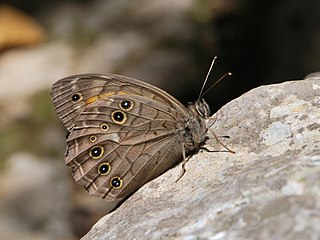
Kirinia roxelana, the lattice brown, is a butterfly of the family Nymphalidae. It is found in southeastern Europe and the Near East. The butterfly is on wing between May and July. The larvae feed on various grasses.

Erebia pandrose, the dewy ringlet, is a member of the subfamily Satyrinae of the family Nymphalidae. It is found from the Arctic areas of northern Europe, the Pyrenees, Alps, the Apennine Mountains, the Carpathian Mountains, Kola Peninsula and Kanin Peninsula, part of the Ural and the Altai and Sayan Mountains up to Mongolia.

Melanargia russiae, or Esper's marbled white, is a butterfly in the family Nymphalidae. It is found in Spain, Portugal, south-eastern France, Italy, the Balkans, southern Russia, the Caucasus and western Siberia.

Apamea sublustris, the reddish light arches, is a moth of the family Noctuidae. The species was first described by Eugenius Johann Christoph Esper in 1788. It is found in central and southern Europe, Turkey and the Caucasus.
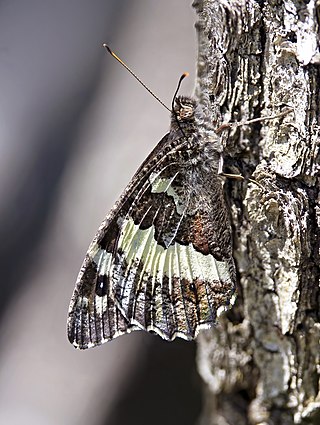
Brintesia is a monotypic butterfly genus in the family Nymphalidae and subfamily Satyrinae. Its one species is Brintesia circe, the great banded grayling.
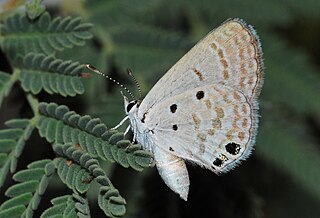
Luthrodes galba, the Persian grass blue, is a butterfly in the family Lycaenidae. It is found in southern Turkey, central and eastern Arabia, Iraq, Iran, Afghanistan, the Caucasus and Cyprus.
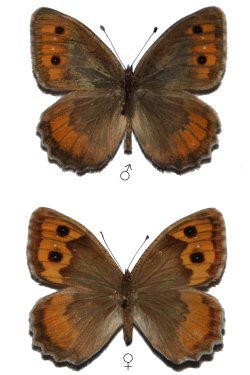
Pseudochazara mniszechii, the tawny rockbrown, is a species of butterfly in the family Nymphalidae. It is confined to Greece, Turkey, northern Iran, Balochistan, and the Caucasus.

Polyommatus admetus, the anomalous blue, is a butterfly of the family Lycaenidae. It was described by Eugenius Johann Christoph Esper in 1783. It is found in south-eastern Europe and Turkey.

Arethusana is a butterfly genus from the subfamily Satyrinae of the brush-footed butterfly family (Nymphalidae). It is composed of only one species, Arethusana arethusa, the false grayling.
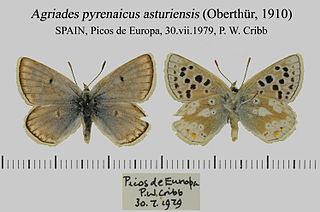
Agriades pyrenaicus, the Gavarnie blue, is a Palearctic butterfly of the family Lycaenidae. It is found in the Asturias mountains of north-western Spain, the Pyrenees, the southern Balkan Peninsula, Turkey, the Caucasus and Armenia. The habitat consists of alpine grassy rocky meadows where it is found at altitudes ranging from 1,500 to 2,200 meters.
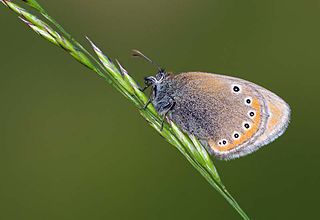
Coenonympha leander, the Russian heath, is a butterfly belonging to the family Nymphalidae. It is found in northern Greece, Hungary, Bulgaria, southern Russia, Asia Minor, Armenia and Iran. The habitat consists of warm grassy areas.

Lysandra corydonius, the false chalkhill blue, is a butterfly of the family Lycaenidae. The species is distributed in south-eastern Europe, Caucasus, Transcaucasia, north-eastern Turkey, and north-western Iran. L.corydonius is very similar to Lysandra coridon but a slight violet sheen is present, especially in the outer area of the wings. It inhabits a wide variety of grasslands and woodlands. In Armenia it occurs from 1200 to 2000 m above sea level. The known larval host plants of the species in Turkey is Hippocrepis comosa, in the Caucasus - Coronilla varia. The species has not been assessed for the IUCN Red List. In Armenia from 2003 to 2013 its population increased.
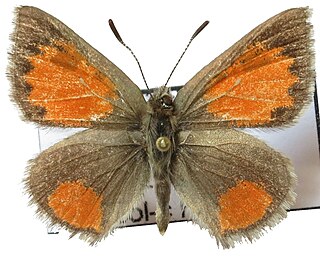
Tomares callimachus, the Caucasian vernal copper, is a butterfly of the family Lycaenidae. It is found in Anatolia, Iraq, Iran, the Caucasus, and Transcaucasia.

Neolysandra coelestina is a butterfly found in the Palearctic that belongs to the blues family.




















